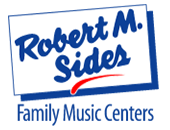
Piano Home | Acoustic Pianos | Digital Pianos | Keyboards | Restored/Pre-Owned Pianos | Piano Restoration
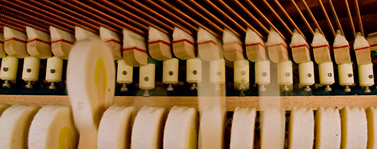 Acoustic Pianos
Acoustic Pianos
Acoustic pianos are percussion instruments that rely on hammers striking strings to produce tone which is amplified by the wood sound board. These pianos have over 10,000 parts, 85% of which are wood, working together to produce any song you can imagine.
There are two basic categories of acoustic pianos- grand pianos and vertical/upright pianos.
 Vertical pianos come in three sizes.
Vertical pianos come in three sizes.
· Spinet - under 40” in height
· Console - 40” – 44” in height
· Studio - 45” – 52” in height
Regardless of height, most vertical pianos require 5’ of wall space and 24” to 30” of space away from the wall to accommodate the piano and a bench.
While the smaller spinet pianos enjoyed great popularity for many years, there are very few pianos manufactured today in that size. Players and teachers alike prefer the superior tone, touch and volume of sound produced by console and studio pianos. It’s important to note that as a piano gets taller, the bass strings get longer and the wood sound board increases in surface area, producing tone and sound with greater ease in a wide dynamic range. Therefore, bigger is better only when comparing piano's of the same quality. There are very good instruments in most sizes, so it is wise to choose the right mix of touch, tone and appearance that’s right for your needs and budget.
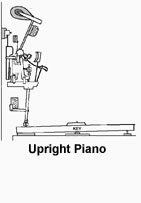 |
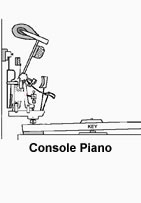 |
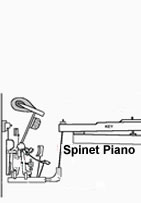 |
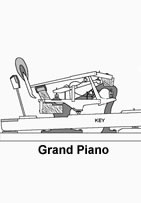 |
One of the reasons that console and studio pianos are preferred is due to the design and geometry of the “action” that connects the key to the hammer. In the diagram you can see that the studio and console pianos have “direct” actions, in that the key pushes 100% of the pressure applied up into the action mechanism and into the hammer. The short height of the spinet piano forces the key and hammer to be at the same height on the piano. Therefore, this “indirect” action requires the key to pull up on action to trigger the hammer into the string. Couple this difference along with the added bass string length and soundboard, and you get a lot more piano in the same 5’ x 2’ space.
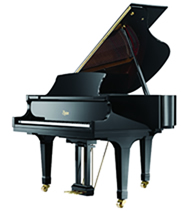 Grand Pianos
Grand Pianos
Grand pianos come in a variety of sizes measured from the edge of the keys to the tip of the curved tail.
• Baby Grand - Under 5’2” in length
• Medium Grand - 5’3” - 6’10” in height
• Concert Grand - 7’ - 9’ in height
A quality grand piano should be considered if space and budget permit. Due to its design, a grand piano has certain inherent advantages over vertical pianos.
 • Touch: The gravity-based action of a grand allows for faster repetition of notes and for better control of the subtleties in expression and tone.
• Touch: The gravity-based action of a grand allows for faster repetition of notes and for better control of the subtleties in expression and tone.
• Tone: The open design both above and below the soundboard allows tone to develop naturally and directly.
• Appearance: Aesthetically, a grand piano can be an elegant and dramatic addition to any décor.
However, space and budget are often major considerations and, just as with the vertical pianos, not all grands are created equal. A quality studio vertical piano is an excellent instrument, and will often have superior touch and tone compared to a poorly made, inexpensive, small grand piano. If it looks like a small grand but lacks and bass and volume compared to other similarly sized grands, we often refer to that as a Grand-Shaped Object, or GSO.
